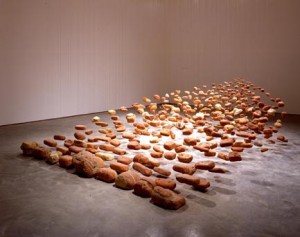 Bennett, Jane. 2010. Vibrant Matter: A Political Ecology of Things. Durham: Duke University Press.
Bennett, Jane. 2010. Vibrant Matter: A Political Ecology of Things. Durham: Duke University Press.
Bennett begins her book stating, “This book has a philosophical project and, related to it, a political one” (vii). And, indeed, her book sometimes reads as a sort of manifesto—though I suspect she would shy away from the term. The spectre haunting humanity is, in this case, the vitality of things, and her goal is to advocate for “the material agency or effectivity of nonhuman or not-quite-human things,” including everything from electrical systems and stem cells to fatty acids and metal (ix). Although the project obviously depends on a demanding and intricate architecture of argument built by particular conceptualizations of terms—“agency,” for one—and diverse bodies of thought (vitalism, post-humanism, etc.), it all seems to come effortlessly to Bennett. And the result is for the most part surprisingly accessible. Overall, the point is that her vision of “vital materialism” would replace the “image of dead or thoroughly instrumentalized matter [that] feeds human hubris and our earth-destroying fantasies of conquest and consumption” (ix).
Bennett’s more distributive understanding of agency is based on Bruno Latour’s notion of an “actant,” Deleuze and Guattari’s “assemblage,” and the extension of her own work on “affect,” which in this case is extended beyond human bodies. “What I am calling impersonal affect or material vibrancy is not a spiritual supplement or “life force” added to the matter said to house it. Mine is not a vitalism in the traditional sense; I equate affect with materiality, rather than posit a separate force that can enter and animate a physical body” (xiii). Throughout the empirical content, Bennett discusses how agency “resides” in human/non-human and non-human assemblages, or, as she prefers, “agentic assemblages” (21) or “agentic swarm” (32).
My favorite chapter illustrates this point of acephalous effects without subjects by discussing the black out that hit the northeastern coast of North America in August 2003. She shows how the black out popped from a far-flung set of actants: “coal, sweat, electromagnetic fields, computer programs, electron streams, profit motives, heat, lifestyles, nuclear fuel, plastic, fantasies of mastery, static, legislation, water, economic theory, wire, and wood” (25). With this, she argues against notions of agency pinned by intention-effect-causality, which she sees as a “conceit” of humanity as “the sole or ultimate wellspring of agency” (30); instead, she advocates a swarmy theory of agency that “does not posit a subject as the root cause of an effect” (31). Taking this stance, she warns against accounts that claim this banner, but then smuggle “human intentionality” back into their analysis at the last instance.
Throughout the chapters, Bennett engages deep philosophical conversations with various thinkers: Kant, Spinoza, Nietzsche, Thoreau, Darwin, Adorno, Deleuze, and more. The chapter on “Neither Vitalism nor Mechanism,” which reviews and extends the ideas of Kant, Henri Bergson, and Hans Driesch had some parts that were really interesting, but I have to admit that most of it was beyond my grasp since it takes the reader’s familiarity with these philosophical positions as somewhat given. Nonetheless, she begins the chapter with a provocative gesture: “Such a vital materialism would run parallel to historical materialism focused more exclusively on economic and social structures of human power” (62).
Bennett tempers the desirable political valences of vitalism by showing how it has conjoined “evangelical Christian notions of a ‘culture of life’ and a doctrine of preemptive war” (69)—the subject of chapter 6. She also briefly touches on the Third Reich’s distorted and coopted Driesch’s work into a kind of hierarchical vitalism (despite his objections) (83).
Drawing from Dewey and Rancière, the penultimate chapter culminates the arguments of the book by positing how vital materialism might broaden our thinking about what constitutes political community and democratic practice. In this view, the democratic “public” would be extended beyond human bodies and those with voice by highlighting human and non-human interdependencies in more horizontal—though not totally flattened—relations.
The book gave me a lot to think about in terms of how I approach and think about my own work. It also offers a lot of interesting political insights depite my being more than a little skeptical about material vitalism’s possibilities of broad-based political appeal and efficacy.

Pingback: Links of the Week | Time's Flow Stemmed
Greetings, Jane Bennett. Did you ever live in Santa Monica, Callifornia?